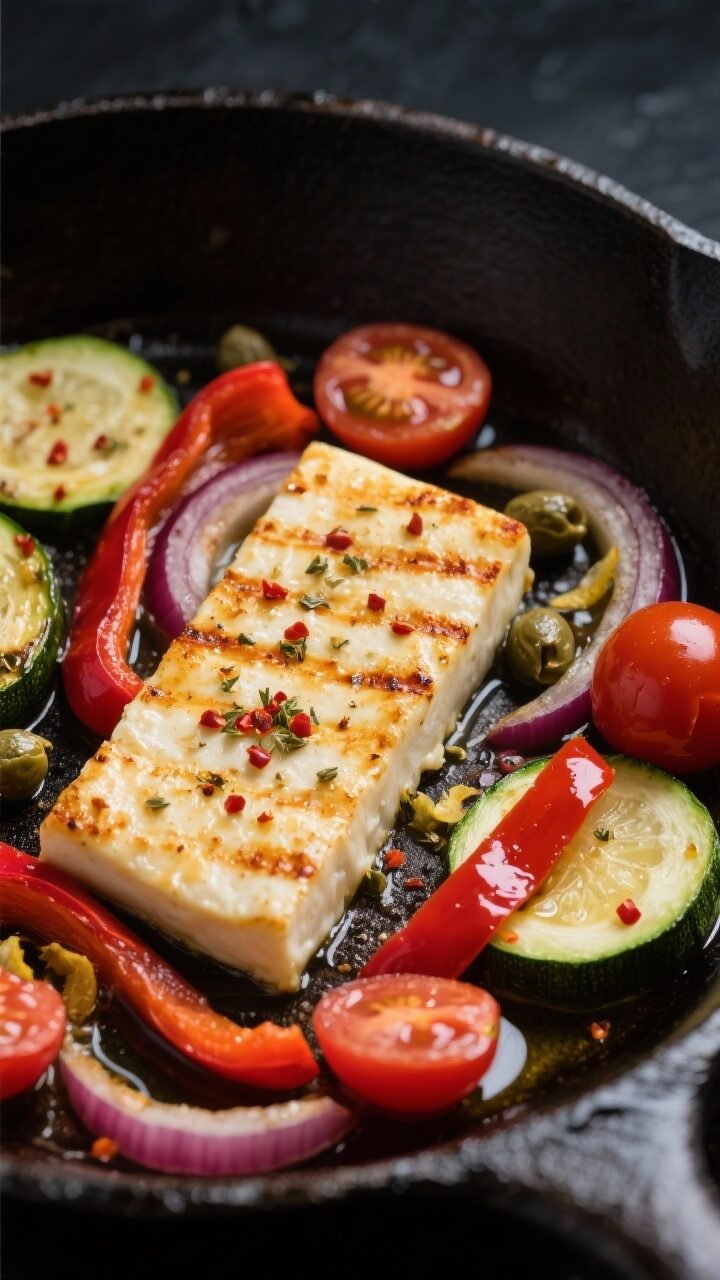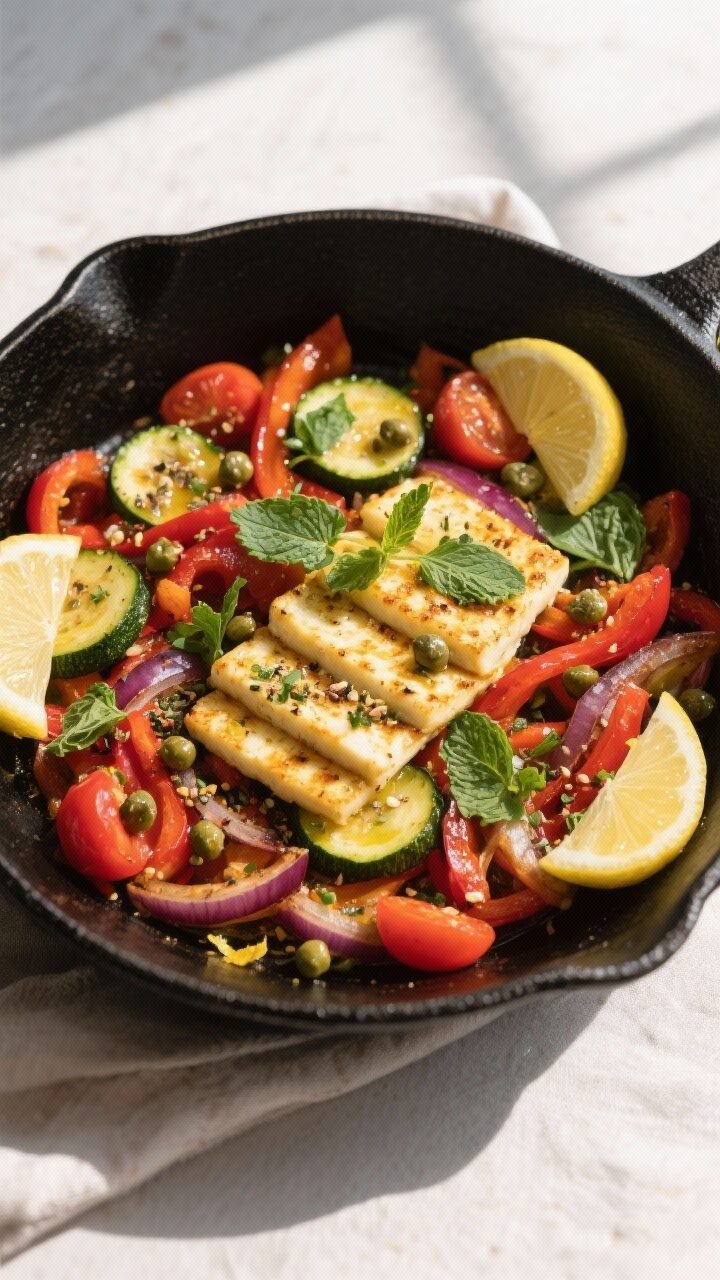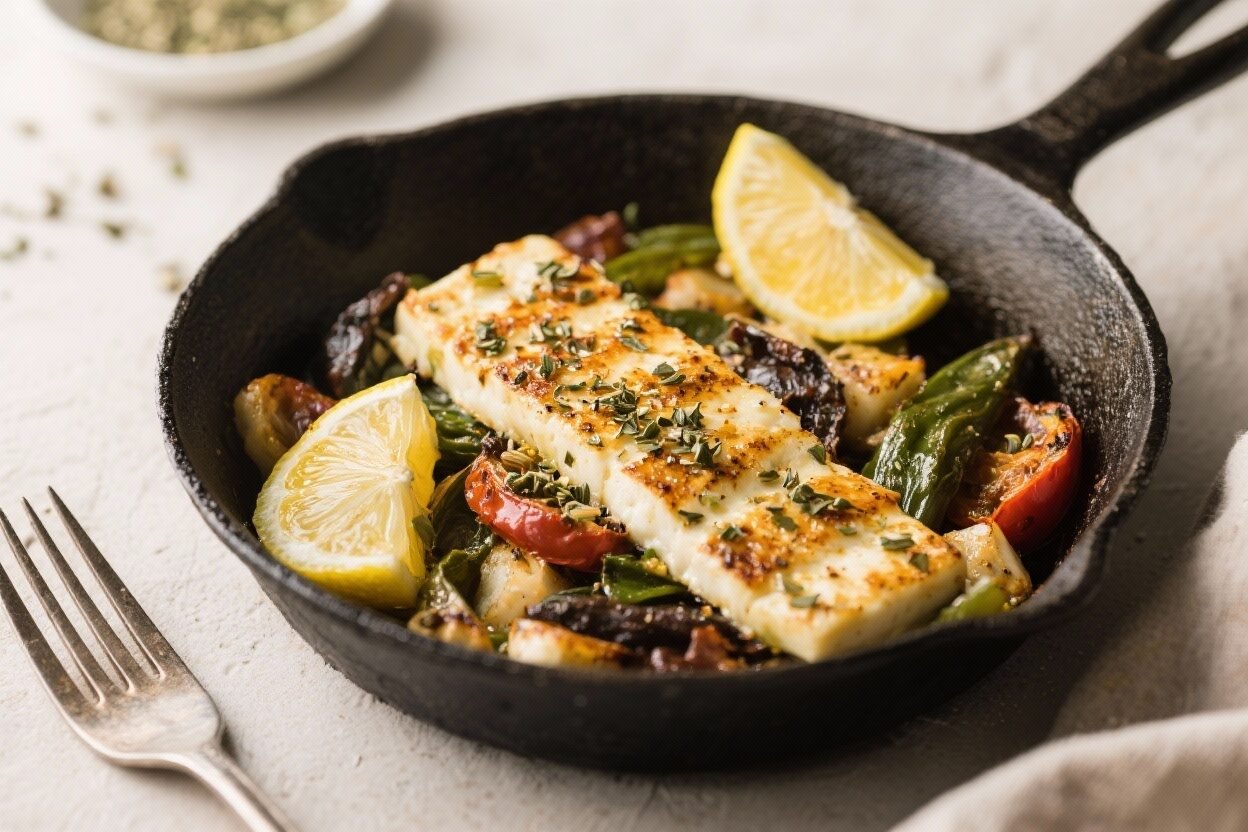If you love bold Mediterranean flavors and quick weeknight cooking, this skillet will become a favorite. Halloumi brings a salty, squeaky bite that crisps beautifully in the pan, while preserved lemon adds a sunny, complex tang you can’t get from regular lemon. A sprinkle of za’atar pulls everything together with a warm, herbal finish.
It’s satisfying, naturally low in carbs, and comes together in one pan without fuss. Serve it as a light meal or pair it with a simple salad for something more substantial.
Why This Recipe Works

- High-heat halloumi sear: Halloumi holds its shape and crisps on the outside while staying tender inside, making it perfect for a quick skillet meal.
- Preserved lemon magic: A little goes a long way. It brings salty-citrus depth that makes the dish taste restaurant-level with minimal effort.
- Za’atar for balance: The thyme-sesame-sumac blend adds earthiness, brightness, and texture.It complements the richness of the cheese and olive oil.
- Low-carb and filling: Plenty of fiber-rich veggies and protein-packed halloumi keep it keto-friendly without feeling restrictive.
- One-pan simplicity: Minimal prep and fast cooking make this great for busy nights or a quick lunch.
Ingredients
- 8 ounces halloumi cheese, sliced into 1/2-inch planks
- 2 tablespoons extra-virgin olive oil, divided
- 1 small red onion, thinly sliced
- 1 red bell pepper, thinly sliced
- 1 small zucchini, halved lengthwise and sliced into half-moons
- 1 cup cherry tomatoes, halved
- 1 clove garlic, minced
- 1 to 2 teaspoons preserved lemon peel, finely minced (rinsed and pith removed)
- 1 to 1.5 teaspoons za’atar, plus more for serving
- 1/4 teaspoon crushed red pepper flakes (optional)
- Sea salt and freshly ground black pepper, to taste
- 1 tablespoon capers, rinsed and drained (optional but recommended)
- 1/4 cup fresh parsley or mint, chopped
- Lemon wedges, for serving (optional)
Step-by-Step Instructions

- Prep the halloumi: Pat the halloumi dry with paper towels. This helps it brown well and avoids steam in the pan.
- Heat the skillet: Warm 1 tablespoon olive oil in a large nonstick or cast-iron skillet over medium-high heat until shimmering.
- Sear the halloumi: Add the halloumi slices in a single layer. Cook 2–3 minutes per side until golden with crisp edges.Transfer to a plate and keep warm.
- Cook the aromatics: Add the remaining 1 tablespoon olive oil. Add the red onion and bell pepper with a pinch of salt. Sauté 3–4 minutes until they start to soften.
- Add zucchini and tomatoes: Stir in the zucchini and cook 2 minutes.Add cherry tomatoes and cook another 2–3 minutes until tomatoes just begin to slump but still hold shape.
- Season the skillet: Stir in garlic, za’atar, and crushed red pepper flakes. Cook 30 seconds until fragrant.
- Fold in preserved lemon: Add the minced preserved lemon peel and capers. Toss gently to distribute.Taste and season with salt and pepper. Remember, halloumi, preserved lemon, and capers are salty, so salt lightly.
- Return the halloumi: Nestle the seared halloumi back into the skillet. Warm for 1–2 minutes so flavors meld.
- Finish and serve: Take off the heat.Shower with chopped parsley or mint and a pinch more za’atar. Serve with lemon wedges if you like a fresh squeeze on top.
How to Store
- Refrigerate: Cool completely, then store in an airtight container for up to 3 days.
- Reheat: Warm gently in a nonstick skillet over medium heat with a splash of olive oil. Avoid microwaving if possible; it can make halloumi rubbery.
- Make-ahead tips: Slice veggies and halloumi a day ahead.Keep preserved lemon pre-minced in a small jar in the fridge for fast assembly.
Why This is Good for You
- Protein-rich: Halloumi offers satisfying protein to keep you full and support a low-carb plan.
- Healthy fats: Extra-virgin olive oil brings heart-friendly monounsaturated fats and antioxidants.
- Fiber and micronutrients: Bell pepper, zucchini, tomatoes, and onion add fiber, vitamin C, potassium, and carotenoids.
- Low-carb profile: The dish keeps net carbs in check without sacrificing flavor or texture.
- Herbs and spices: Za’atar and preserved lemon pack flavor without extra calories, encouraging lighter, satisfying meals.
Pitfalls to Watch Out For
- Over-salting: Preserved lemon, halloumi, and capers are salty. Taste before adding more salt.
- Wet halloumi: If you don’t pat it dry, it won’t crisp and may stick. Dry it well and use a hot pan.
- Burning spices: Add za’atar near the end and cook briefly.Overheating can make it bitter.
- Mushy veggies: Keep the heat medium-high and cook just until tender-crisp. You want some bite.
- Too much preserved lemon: It’s potent. Start with 1 teaspoon, taste, then add more if needed.
Alternatives
- Cheese swaps: Try paneer for a milder profile or firm tofu for a dairy-free option.Both sear well.
- Different veggies: Use eggplant, asparagus, or baby spinach. Keep total volume similar for best results.
- Spice variations: Replace za’atar with Italian seasoning plus a dash of sumac or lemon zest. Or try smoked paprika and oregano for a deeper flavor.
- No preserved lemon? Use 1 teaspoon lemon zest plus a tiny pinch of salt and a squeeze of lemon juice at the end.
- Add protein: For non-vegetarian options, add cooked chicken thigh strips or shrimp at the end and warm through.
- Make it a meal bowl: Serve over cauliflower rice, shredded cabbage sauté, or a bed of peppery arugula.
FAQ
What is za’atar, and where can I find it?
Za’atar is a Middle Eastern spice blend usually made with thyme or hyssop, sesame seeds, and sumac.
You’ll find it in most grocery stores, Middle Eastern markets, or online. Quality varies, so choose a blend with sumac prominently listed for that lemony lift.
Do I need to rinse preserved lemon?
Yes, rinse the peel to remove excess salt. Scrape away the bitter pith, then finely mince the peel.
Start small; you can always add more.
Can I make this dairy-free?
Yes. Swap halloumi for extra-firm tofu, well-pressed and sliced. Sear it until golden on both sides.
Season more assertively since tofu is milder.
Will this fit into a strict keto plan?
In moderate portions, yes. The vegetables used are relatively low in net carbs, and halloumi is high in fat and protein. Adjust tomato and onion amounts if you need to reduce carbs further.
What pan works best?
A well-seasoned cast-iron or a high-quality nonstick skillet works best.
Both allow for a good sear on halloumi without sticking.
How can I make it spicier?
Add extra crushed red pepper flakes, a pinch of Aleppo pepper, or drizzle with harissa at the end. Taste as you go to avoid overpowering the za’atar.
Can I meal prep this?
Yes, but for best texture, sear the halloumi fresh if you can. You can prep and cook the veggies ahead, then reheat and quickly sear halloumi right before serving.
In Conclusion
This Mediterranean Halloumi Keto Skillet with Preserved Lemon and Za’atar brings bright, bold flavor with minimal effort.
It’s crisp, juicy, and herby, with just enough tang to keep each bite exciting. Whether you’re eating low-carb or simply want a quick, vibrant skillet dinner, this one checks all the boxes. Keep a jar of preserved lemons and a tin of za’atar in your pantry, and you’ll have dinner with character anytime.
Printable Recipe Card
Want just the essential recipe details without scrolling through the article? Get our printable recipe card with just the ingredients and instructions.
Printable Recipe Card
Want just the essential recipe details without scrolling through the article? Get our printable recipe card with just the ingredients and instructions.
